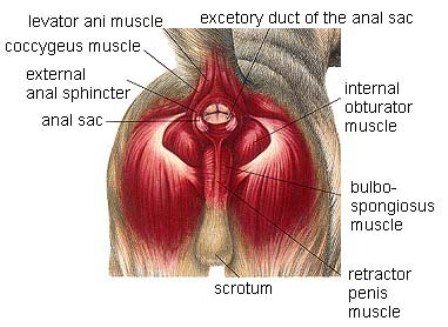Canine Anal Glands and Sacs
Dog Anal Gland Disease QuickLinks
The canine anal glands are located on each side of the anus
where feces exits the body. When feces is released by the body,
it creates a pressure on ducts that lead from the anal sacs. This
pressure causes the sacs to empty. The foul smelling fluid is thought
to be
one of the ways that a dog marks an area or territory by adding a
unique scent to the feces or anus (think of dogs smelling each other at
the anus). The glands themselves have no purpose in a medical sense
(called vestigial).

Picture Canine Anal Glands Anatomy
The
pictures in this section are reprinted with permission by the copyright
owner, Hill's Pet Nutrition, from the Atlas of Veterinary
Clinical Anatomy. These illustrations should not be downloaded, printed
or copied except for personal, non-commercial use.
When the glands are working normally, the pressure caused by a passing stool causes some fluid to be released through ducts in each gland. Liquid will also empty from muscle contractions that occur when your dog is frightened.
Canine anal glands become a problem when the ducts that allow
the fluid to leave the body become blocked or clogged. There are
several reasons why the ducts can become blocked:
- Glands that Produce too much fluid
- Soft stools that can't apply the same pressure as firm stools
- Tumors or Polyps that block the opening
- Anal inflammation (often caused by allergy)
These problems are referred to as dog anal sac disease, anal sac impaction and Sacculitis, which is another name for a canine anal sac infection.
When the pea sized dog anal sacs become swollen you can physically feel them in them by touching the glands which are at the 5 and 7 o'clock positions around the anus. To get some relief your dog may be seen scooting across the floor on his or her anus (rear). If the fluid is not drained, an infection can take hold, causing an abscess.
Expression
If a dog is not showing any symptoms such as smell or changes in
behavior, a veterinarian or owner may want to leave the glands alone.
Squeezing or expressing the glands in order to empty them out could
cause inflammation and discomfort. In dogs that are prone to infection
or that show symptoms, expression by a veterinarian, groomer or by a
trained owner is warranted. Some groomers will express a dog on
every visit.
Infection
If the fluid is infected, it will smell badly and be yellow or black in color. Your dog may have a fever and the any liquid that is expressed or emptied from the gland, beside the bad smell may have a drop of blood or puss.
If you see unusual swelling in the gland then your dog may have an anal abscess, which is another term for blocked fluid, puss and liquid. The area of the gland might be discolored (e.g.;; reddish) in addition to symptoms such as itch, and the fish like smell. Just emptying the gland through pressure will not help and your veterinarian may have to use a lance to make a small opening.
Cancer
The canine anal area has two kinds of glands which are prone to
tumor formation, the perianal glands (also called the circumanal or
hepatoid glands) and the apocrine anal sac glands. Both benign (not
cancerous) and malignant tumors (adenocarcinoma and the less common
adenoma), lymphoma and melanoma canine cancers can form in these
glands. Tumors form in the anal sac walls. The average age of patients
are 10.5 years with a higher incidence of the disease in
Dachshunds, Cocker spaniels and Shepherd dogs. The latest studies show
that castration prior to tumor formation is not a factor.
Anal sac adenocarcinoma is treated with surgical removal, followed in
some cases by tradition therapy and chemotherapy. Adjacent lymph nodes
are also removed since anal gland cancer in dogs can metastasize
(spread) quickly.
Removal
Dog anal gland removal is less common today than it was in the past. The reason is that surgical removal has complications of its own, and elimination of the glands doesn't eliminate underlying problems such as allergy. Anal sac removal is recommended in dogs that are prone to frequent infections or abscesses. The glands are also removed when anal sac adenocarcinoma is diagnosed (followed by radiation).
|
|